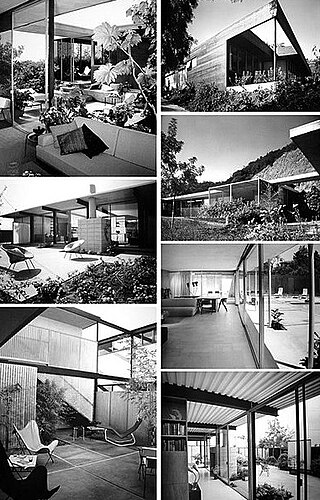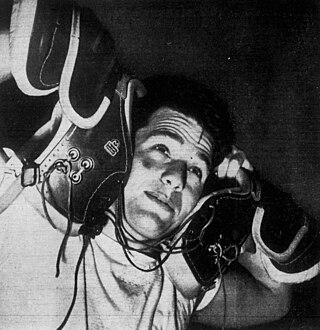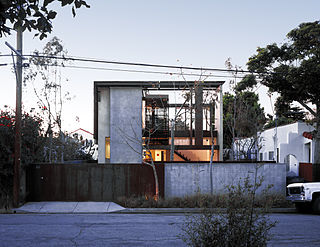
Paul Revere Williams, FAIA was an American architect based in Los Angeles, California. He practiced mostly in Southern California and designed the homes of numerous celebrities, including Frank Sinatra, Lucille Ball and Desi Arnaz, Lon Chaney, Barbara Stanwyck and Charles Correll. He also designed many public and private buildings.

Pierre Francis Koenig was an American architect and a Professor of Architecture at the University of Southern California. He taught at the USC School of Architecture from 1964 until his death in 2004. He was the director of the undergraduate building science program from 1980 to 2004. He lectured widely at other universities, and received more than 20 awards for his work. The architecture of Pierre Koenig was the subject of the book "Pierre Koenig" written by James Steele in 1998. Also in 1998, Koenig was elevated to "Distinguished Professor" after 35 years on the USC faculty. He received the USC Distinguished Alumni Award and the Gold Medal from the Los Angeles chapter of the American Institute of Architects.
Buff, Straub and Hensman is an architectural firm. The office has won more than 30 awards for house designs from the American Institute of Architects. The firm was known as Buff and Hensman when Cal Straub moved to Arizona and later Buff, Smith and Hensman when Dennis Smith bought the practice after Don Hensman's retirement.

Raphael S. Soriano, FAIA, was an architect and educator, who helped define a period of 20th-century architecture that came to be known as Mid-century modern. He pioneered the use of modular prefabricated steel and aluminum structures in residential and commercial design and construction.

Daniel Leonard Dworsky was an American architect who was a longstanding member of the American Institute of Architects College of Fellows. Among other works, Dworsky designed Crisler Arena, the basketball arena at the University of Michigan named for Dworsky's former football coach, Fritz Crisler. Other professional highlights include designing Drake Stadium at UCLA, the Federal Reserve Bank in Los Angeles and the Block M seating arrangement at Michigan Stadium. He is also known for a controversy with Frank Gehry over the Walt Disney Concert Hall.

The Solar Umbrella House is a private residence in Venice, Los Angeles, California, remodeled using active and passive solar design strategies to enable the house to function independent of the electrical grid. The design was inspired by Paul Rudolph’s 1953 Umbrella House for Philip Hanson Hiss III's Lido Shores, Sarasota, development. Originally a small 650-square-foot (60 m2) bungalow, the owners added 1,150 sq ft (107 m2) in 2005, remodeling it in such a way that the house is almost 100% energy neutral.
The USC School of Architecture is the architecture school at the University of Southern California. Located in Los Angeles, California, it is one of the university's twenty-two professional schools, offering both undergraduate and graduate degrees in the fields of architecture, building science, landscape architecture and heritage conservation.
Brenda A. Levin is a Los Angeles-based architect and advocate for historic preservation. A Fellow of the American Institute of Architects (AIA), her major projects include the restoration of iconic L.A. landmarks like the Bradbury Building, the Griffith Observatory, the Wiltern Theatre, City Hall, Grand Central Market, and Dodger Stadium.
Hodgetts + Fung, also known as HplusF, is an interdisciplinary design studio based in Culver City, California specializing in architectural design, advanced material fabrication, historical restorations, and exhibition design and is led by principals Craig Hodgetts and Hsinming Fung.

Frederick B. Fisher, AIA, FAAR, is an American architect whose professional practice is headquartered in Southern California. Frederick Fisher started his architecture firm in 1980 which partnered architects Joseph Coriaty and David Ross in 1995. Fisher is most noted for building seminal academic institutions, museums, and contemporary residential projects throughout the United States, Europe and Asia. His approach to architecture comes from a broad cultural and social perspective.

Elena Manferdini is an Italian architect based in Venice, California, where she is the principal and owner of Atelier Manferdini. She is the Graduate Programs Chair at the Southern California Institute of Architecture (SCI-Arc). She has over fifteen years of professional experience that span across architecture, art, design, and education.

Ralph Lewis Knowles is an American professor emeritus of architecture and a leading theorist of solar access design. He created the concept of the "solar envelope" and championed solar access planning. The solar envelope has influenced many city design and planning documents. He is a fellow of the American Solar Energy Society and an ACSA Distinguished Professor. He received the prestigious AIA Medal for research in 1974.
Annie Chu, FAIA, is a Chinese-American architect, interior designer, and academic based in Los Angeles.

Karen M. Kensek is on the faculty of the USC School of Architecture at the University of Southern California. She is a leading figure in architectural computing, focusing on analytical building information modeling and building science.
Alvin Huang is a Chinese-American architect, educator, and designer based in Los Angeles, California. He is the founder of Synthesis Design + Architecture and an associate professor at the USC School of Architecture. In 2020, he was appointed the Director of Graduate & Post-professional Architecture at the USC School of Architecture.
Marcelo Spina is an Argentinean-American architect (AIA) and educator. He is a partner in PATTERNS, which is a Los Angeles-based architecture firm. He founded PATTERNS in 2002. Since 2001, he has been a Design and Applied Studies Faculty at the Southern California Institute of Architecture, SCI-Arc.

Victor A. RegnierFAIA is an American architect, professor, and researcher. His research and publications have explored the creation and evaluation of residential settings for the physically and cognitively frail with special attention to northern European precedents.

Doris Kim Sung is a Korean American architect and educator. Sung serves as the Director of the Undergraduate Programs at the USC School of Architecture starting in 2020.
Georgina Huljich is an Argentinean-American architect and educator. She is a partner in PATTERNS, a Los Angeles-based architecture firm. She has been teaching at the Department of Architecture and Urban Design at UCLA as an associate professor since 2006.
Robert S. Harris, FAIA, is an Architect, an American professor of architecture, a former Dean, and a civic leader and urbanist. His academic leadership at the University of Southern California and the University of Oregon involved 10-year stints as the Dean of both architecture programs, as well as Chair of the Architecture and Landscape Architecture Departments Programs.











